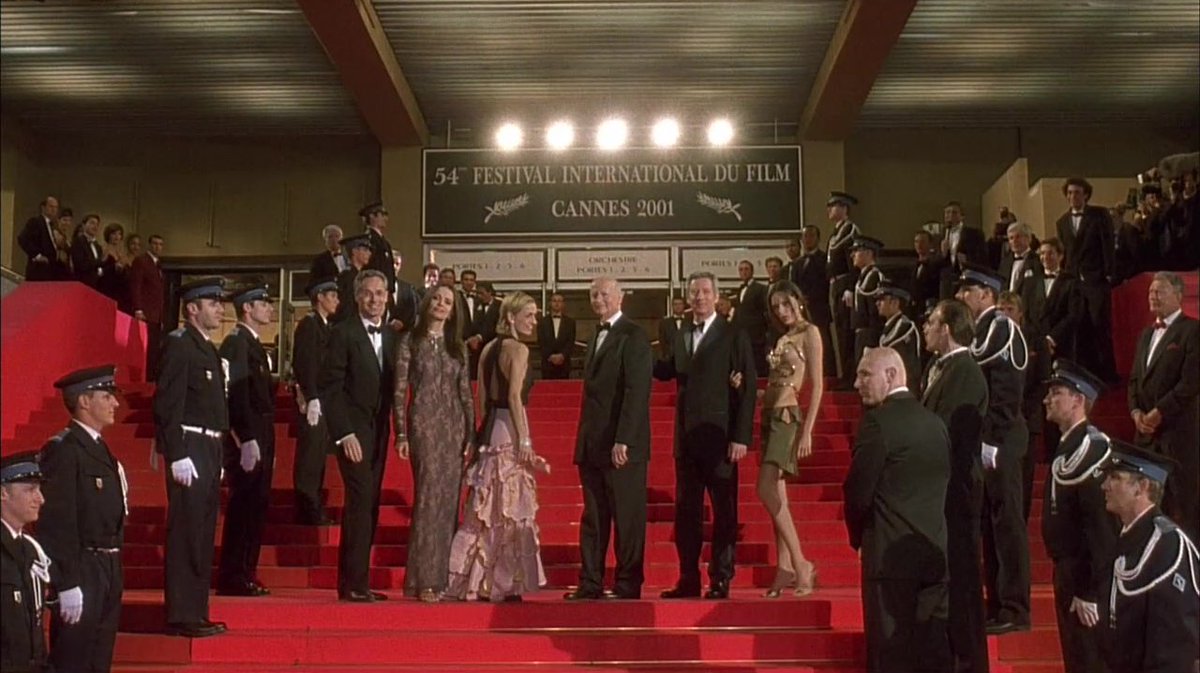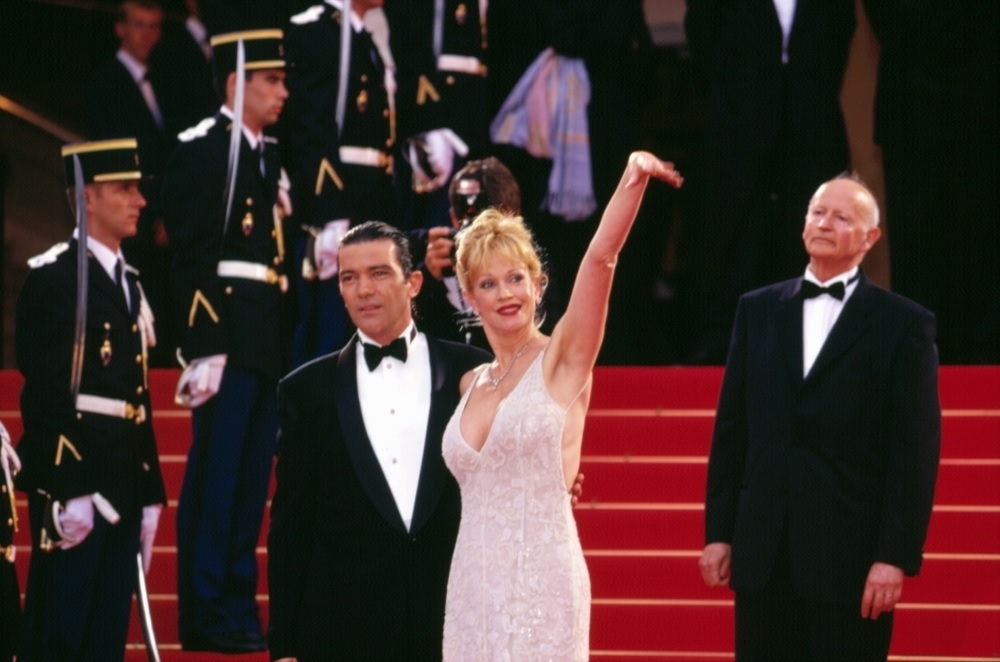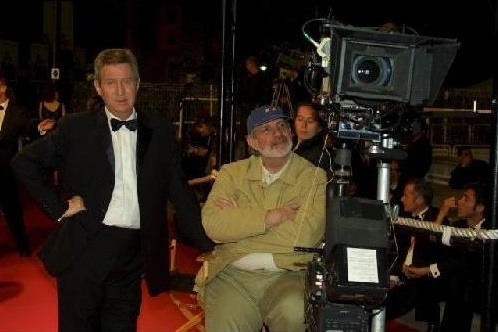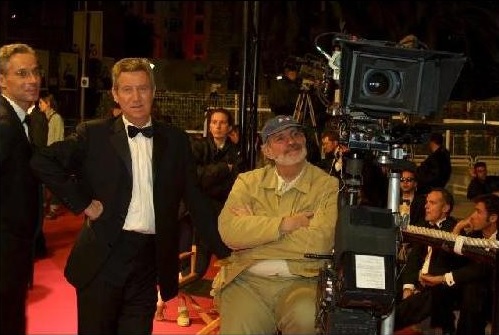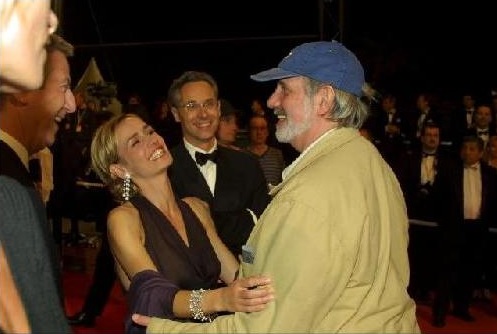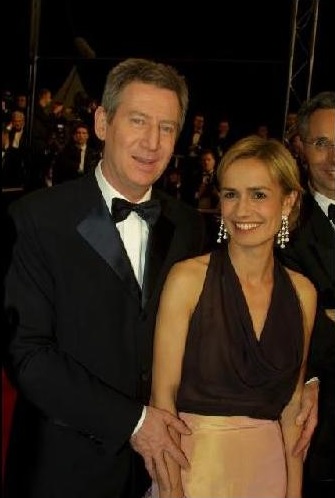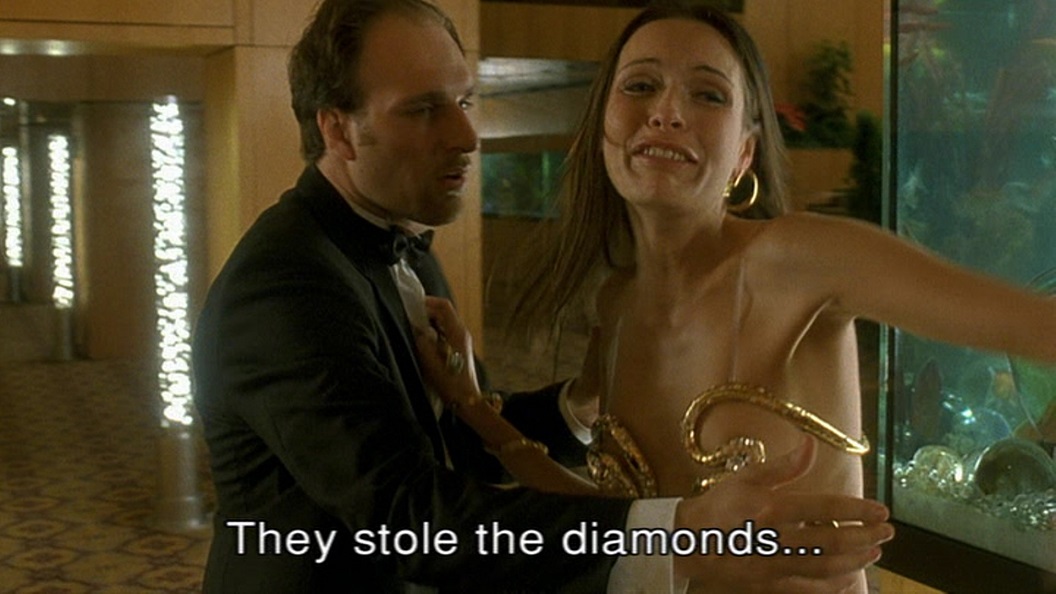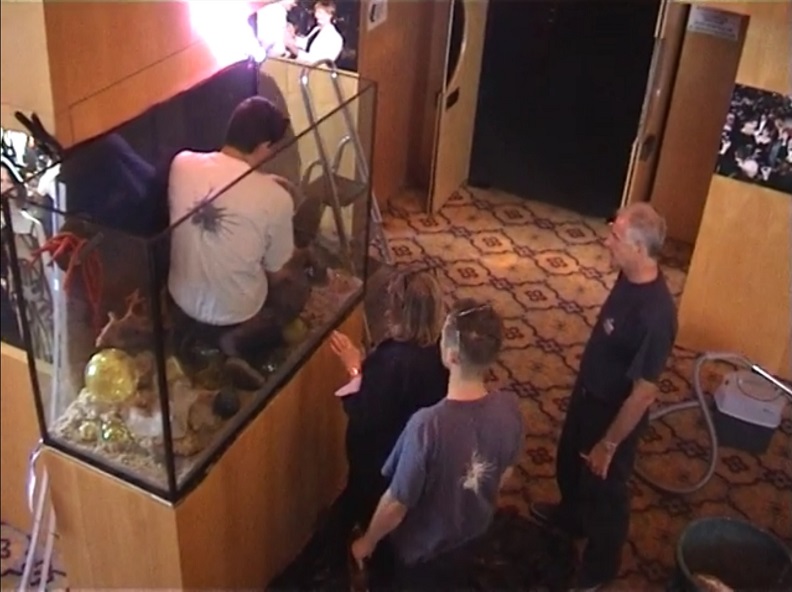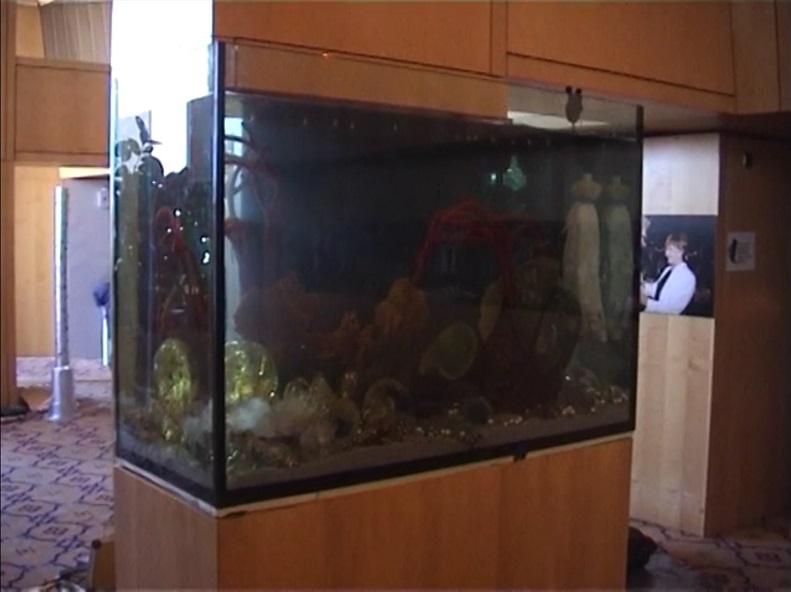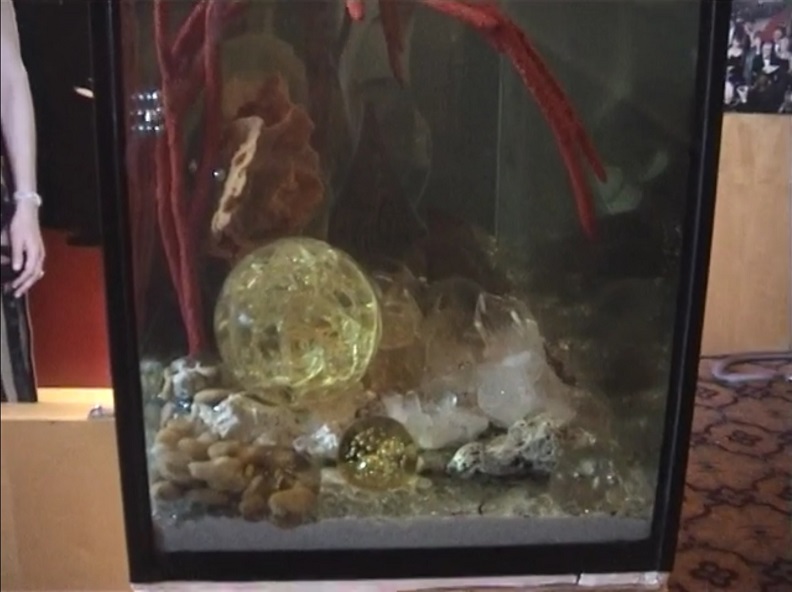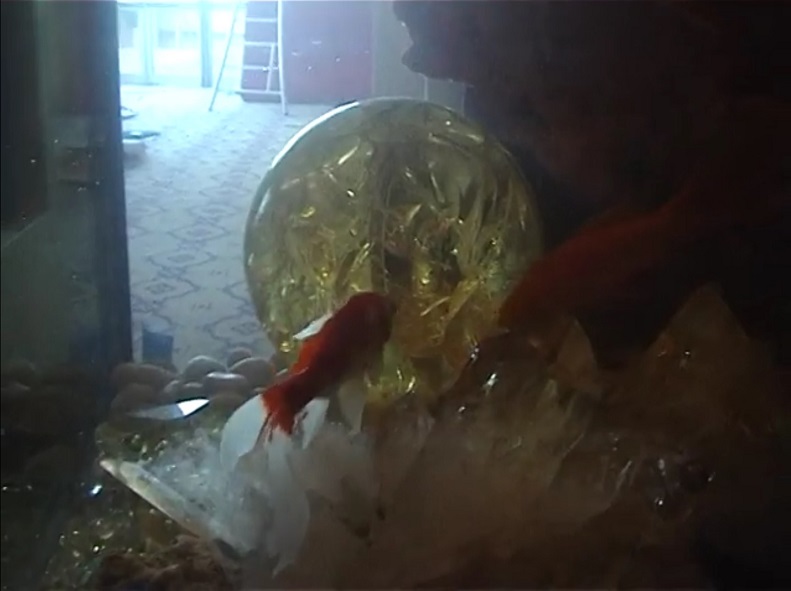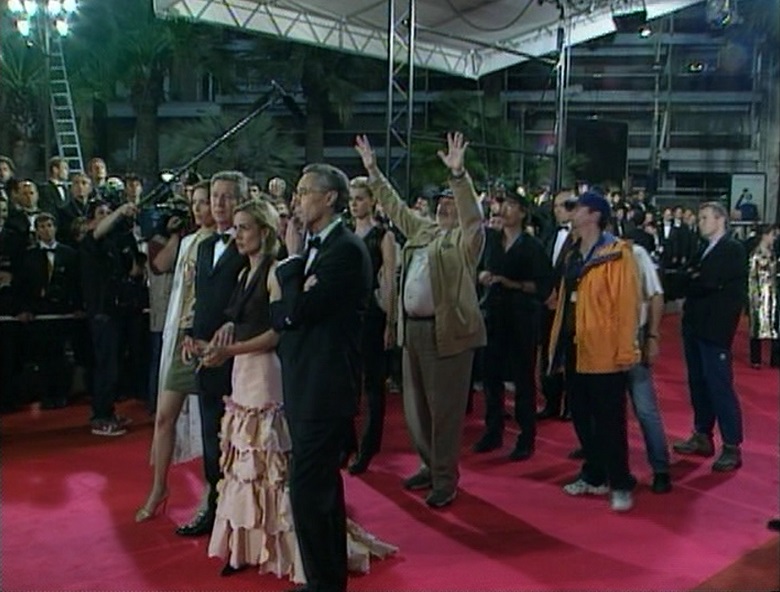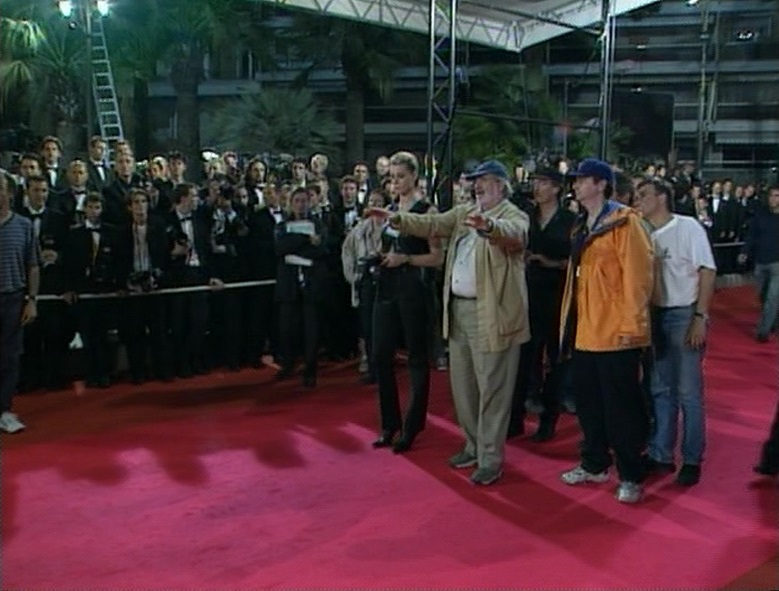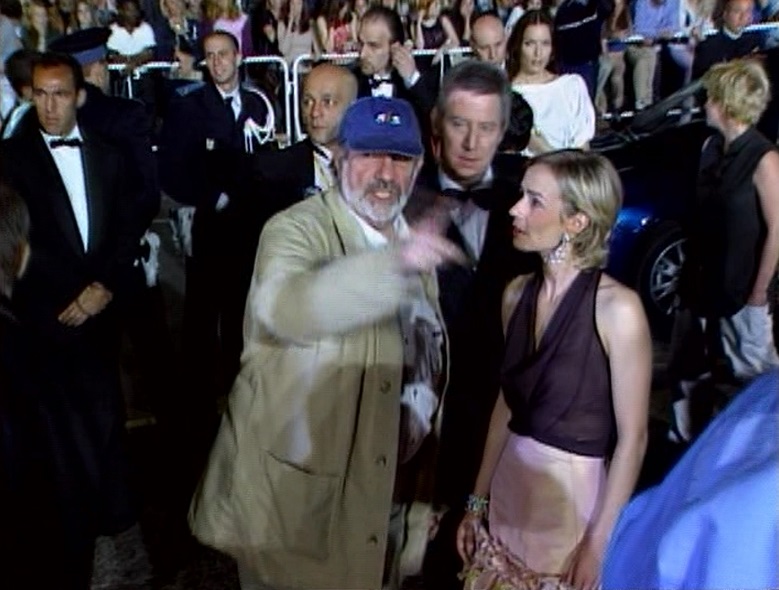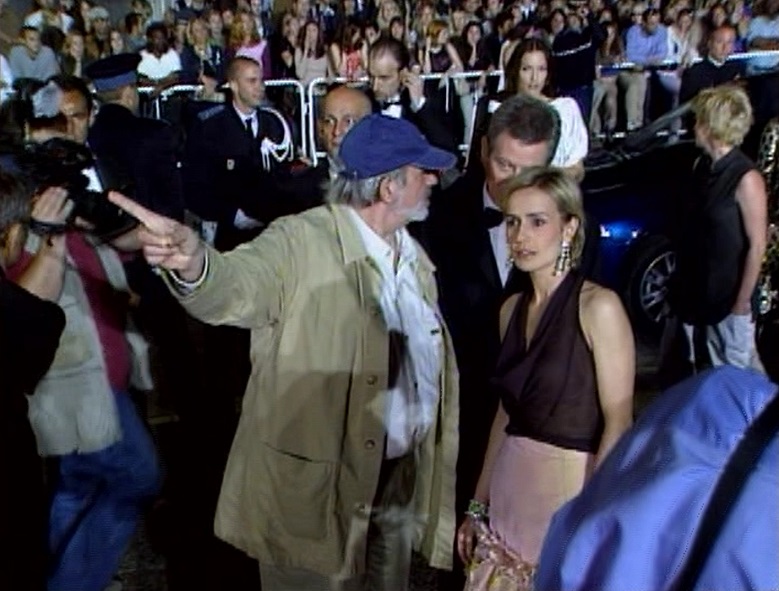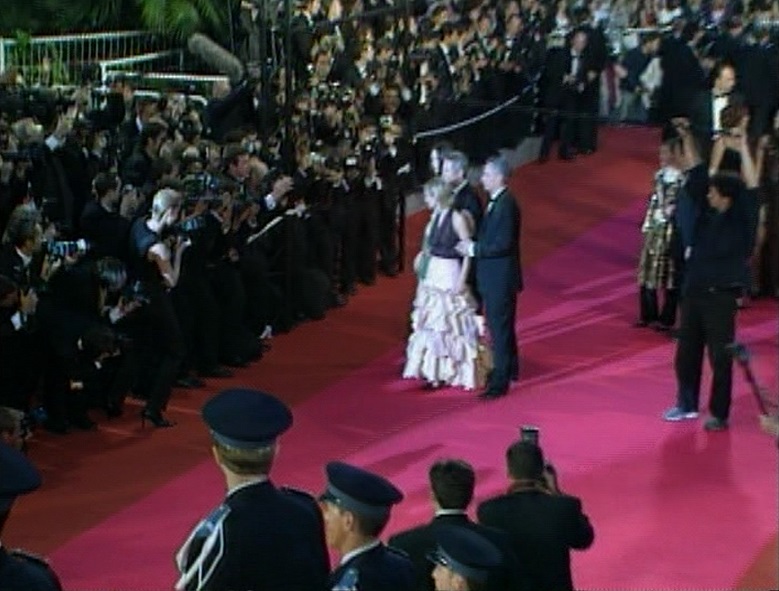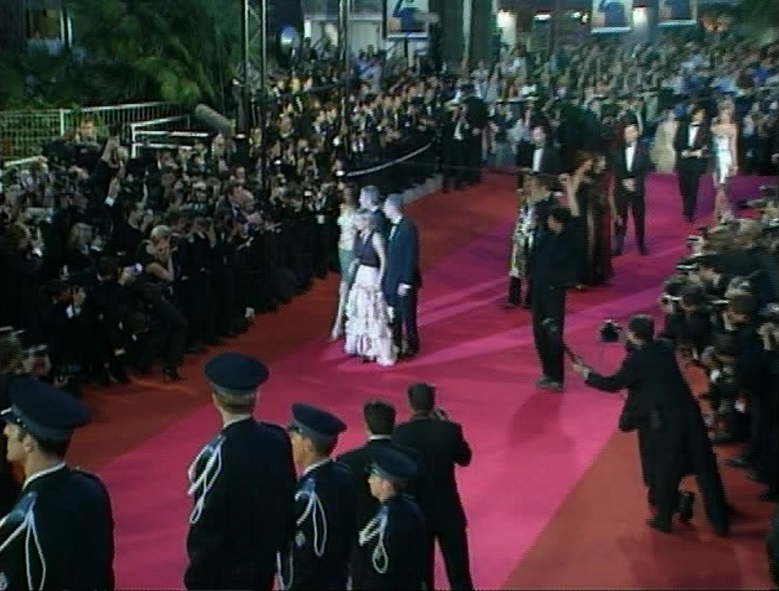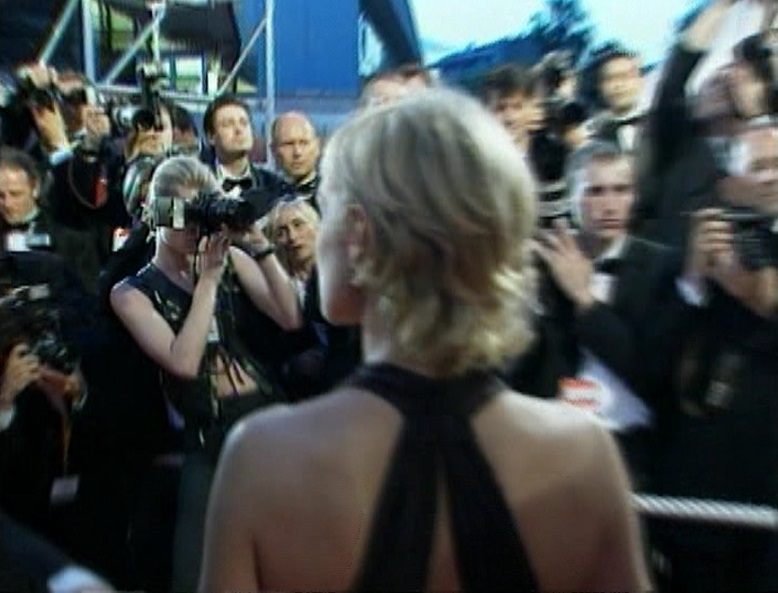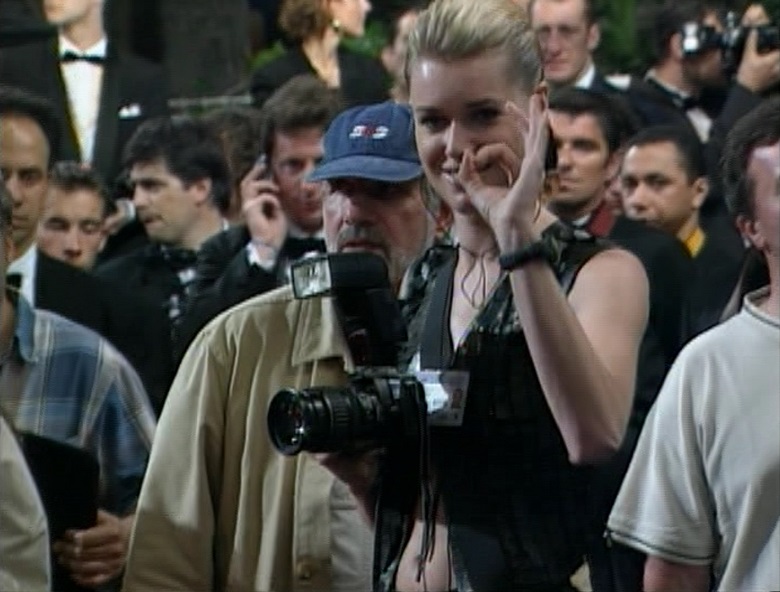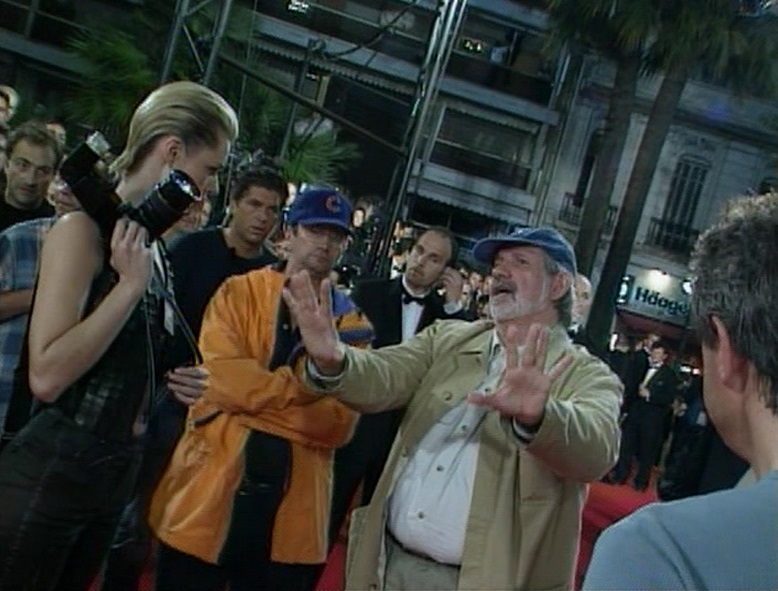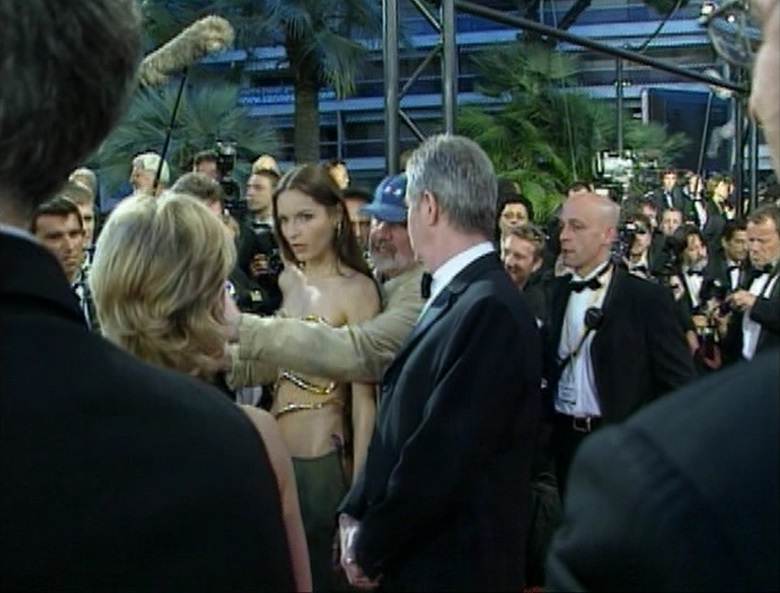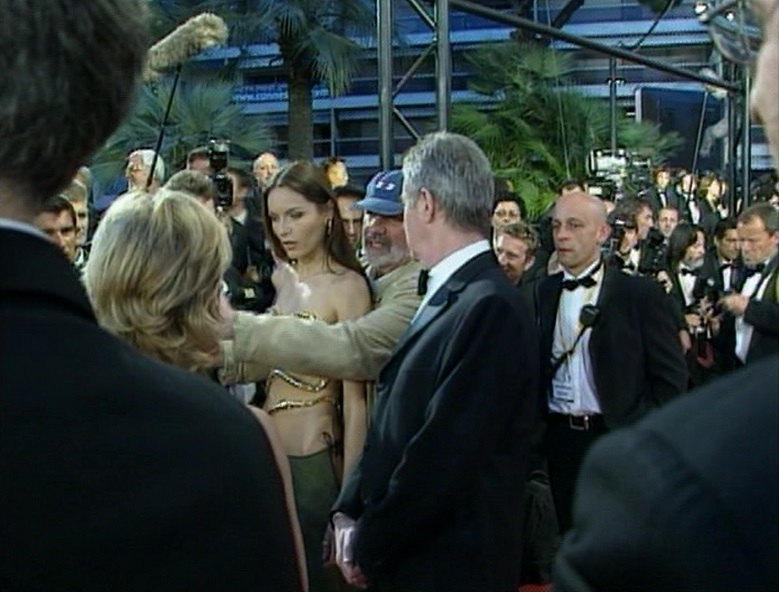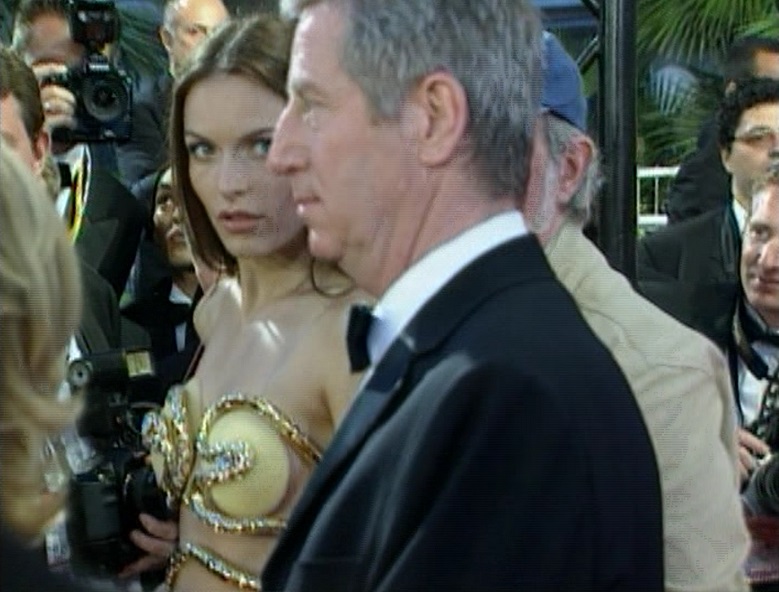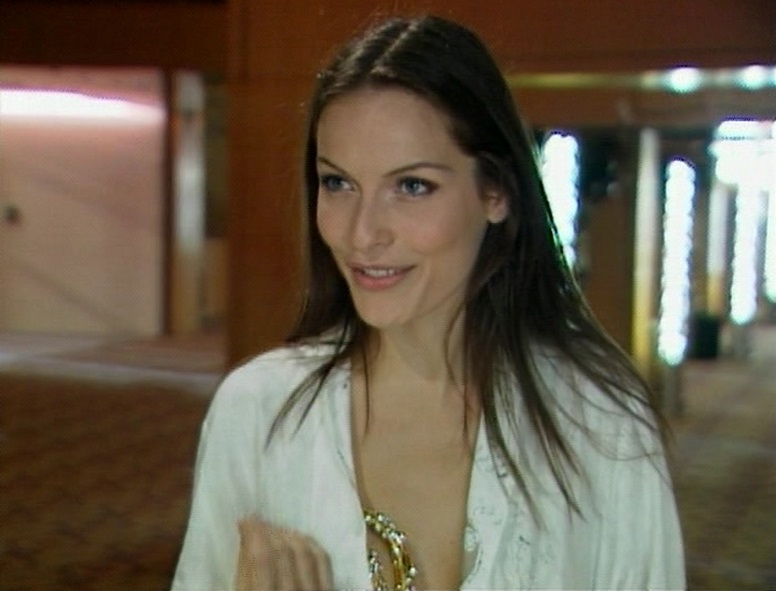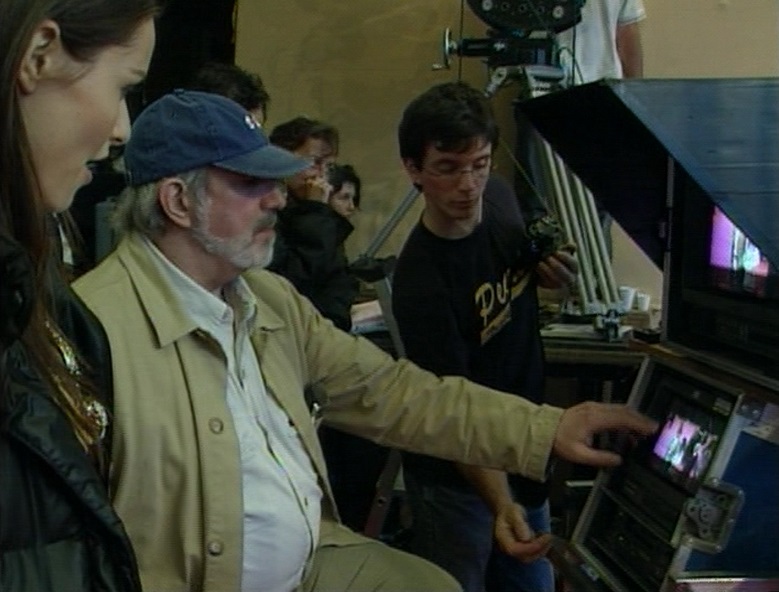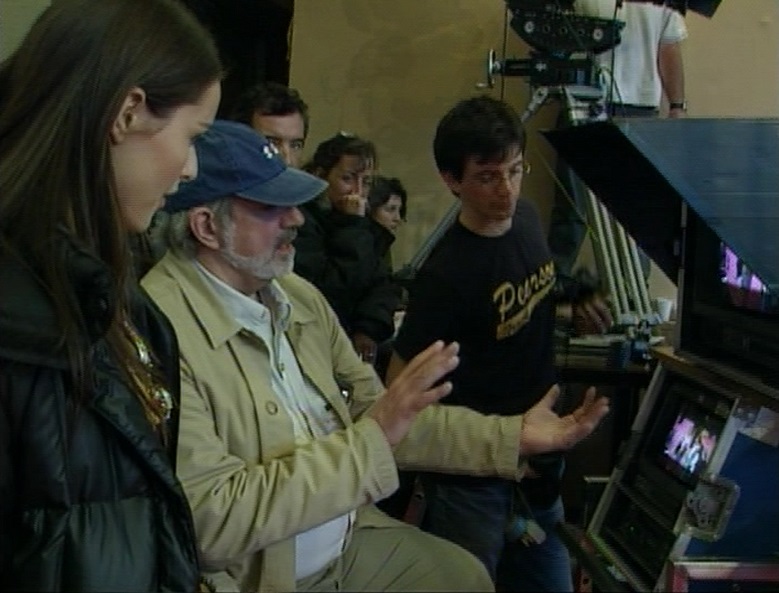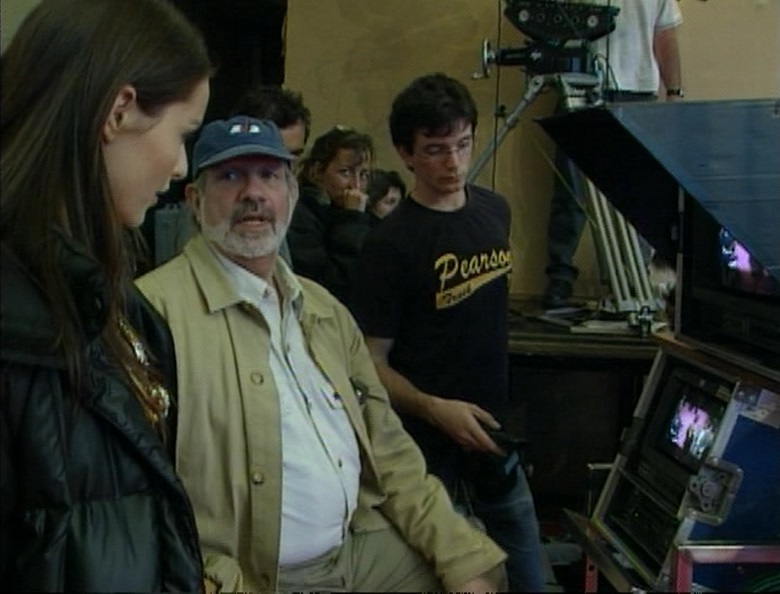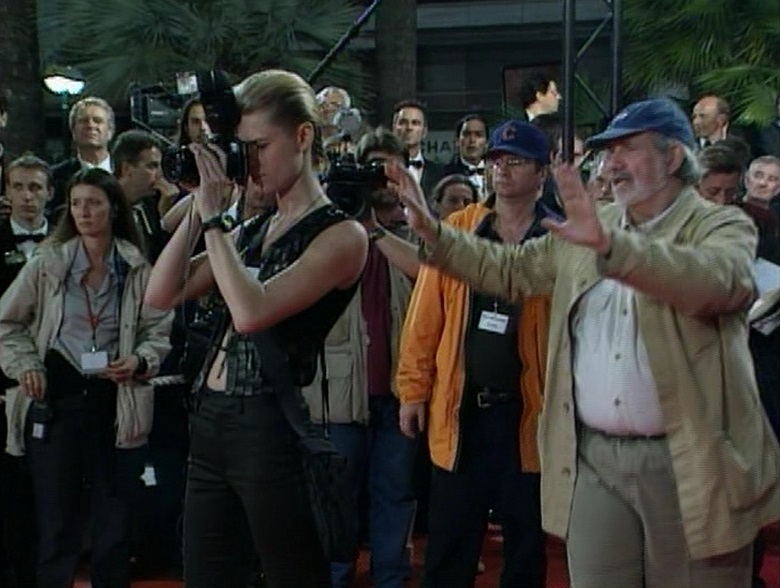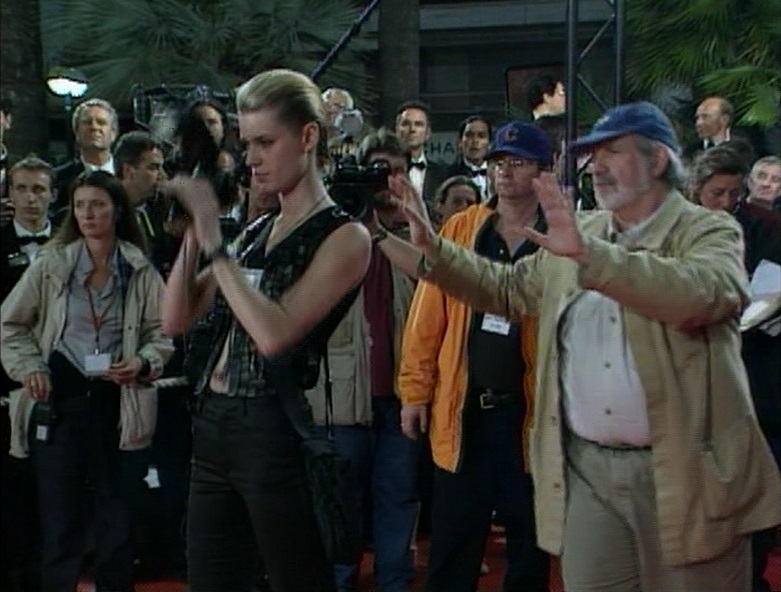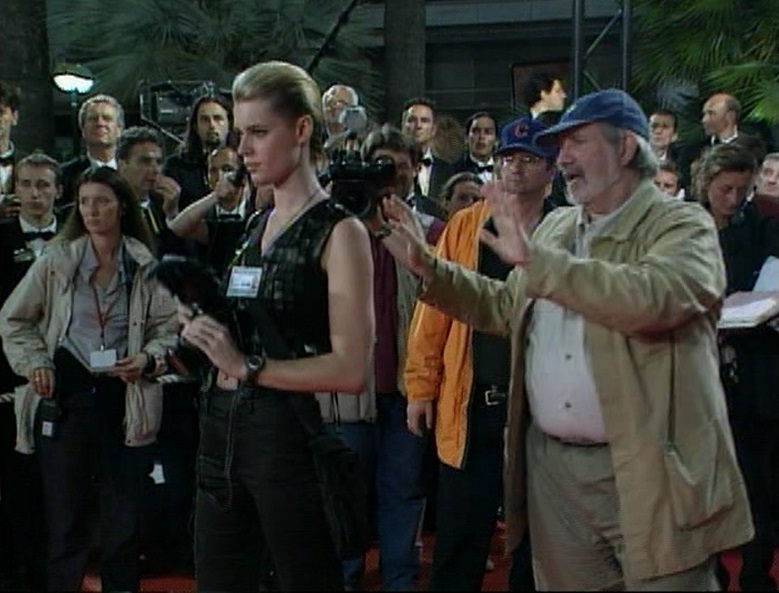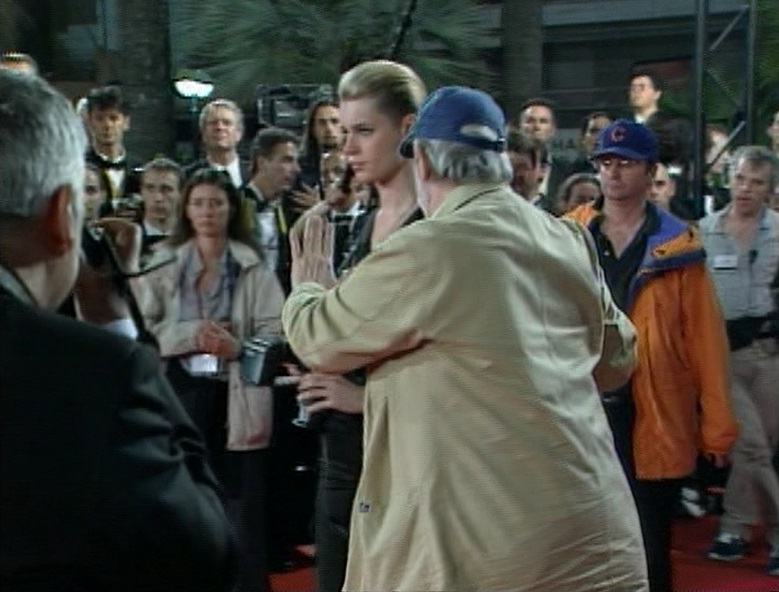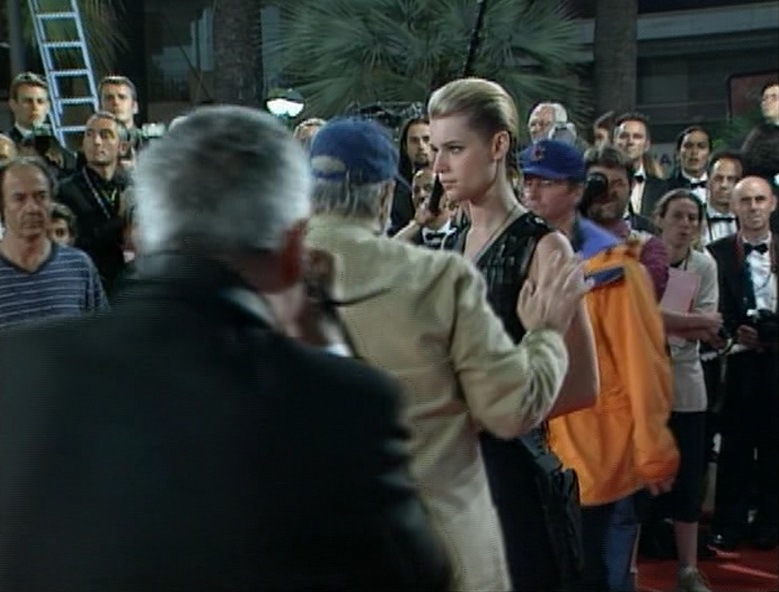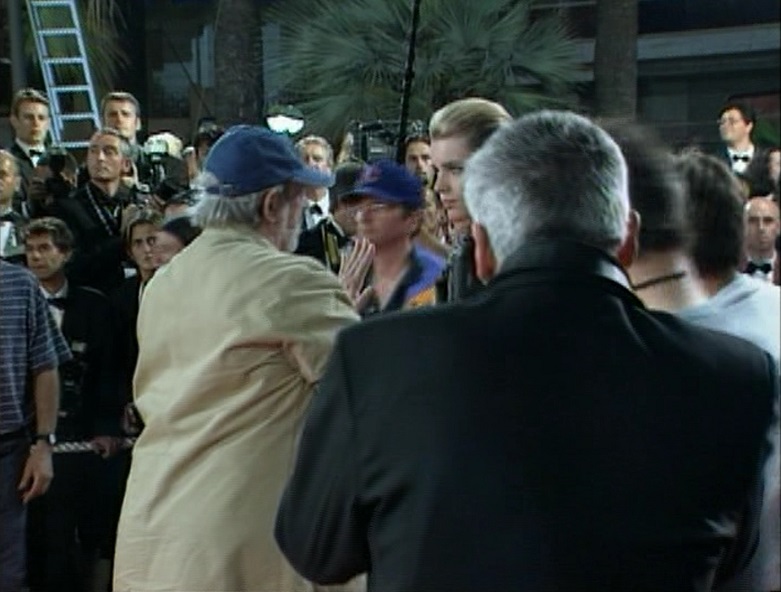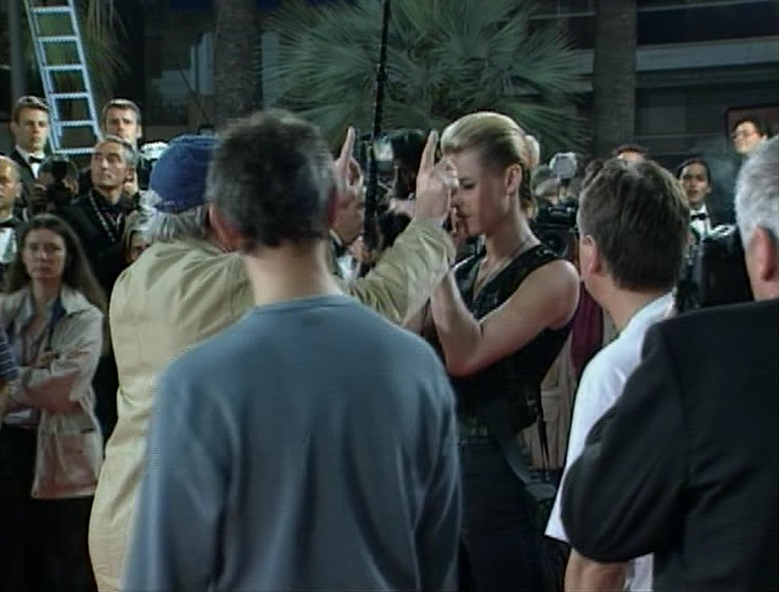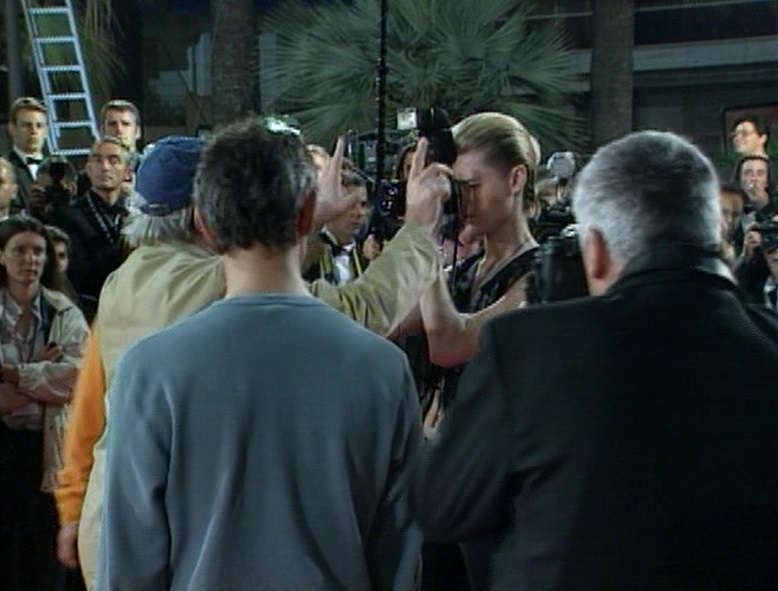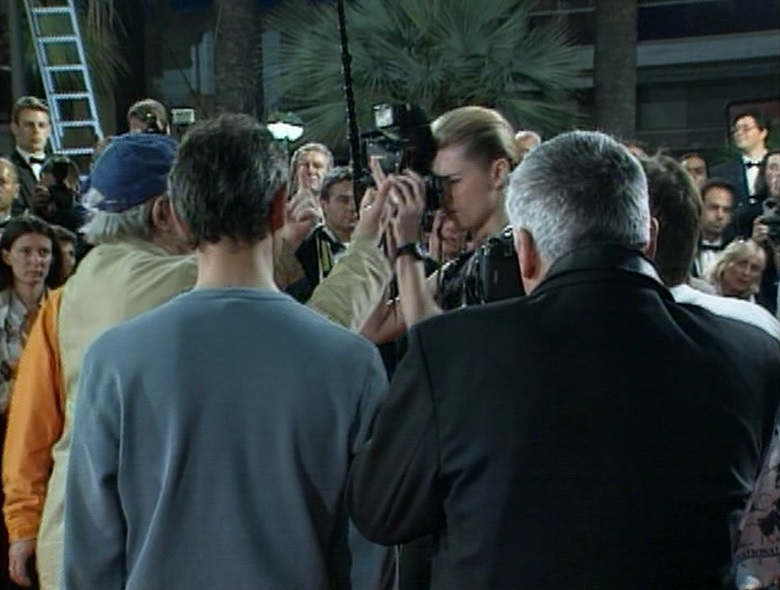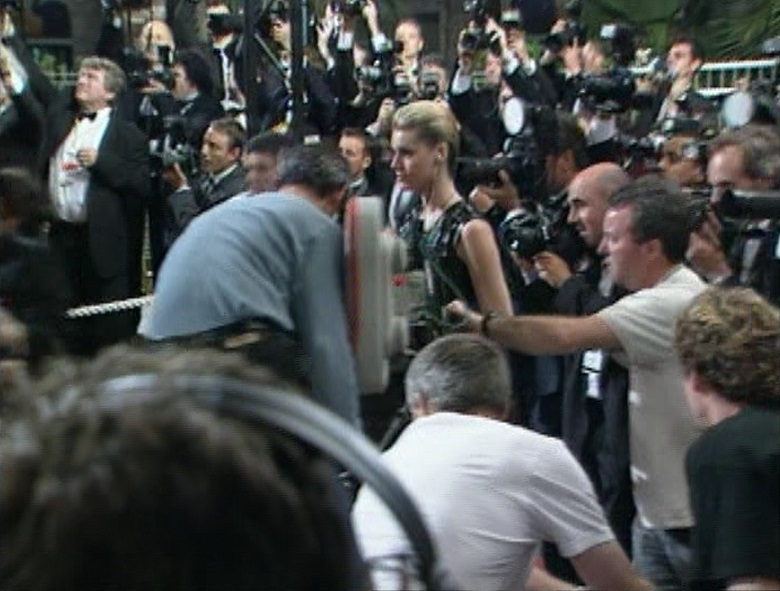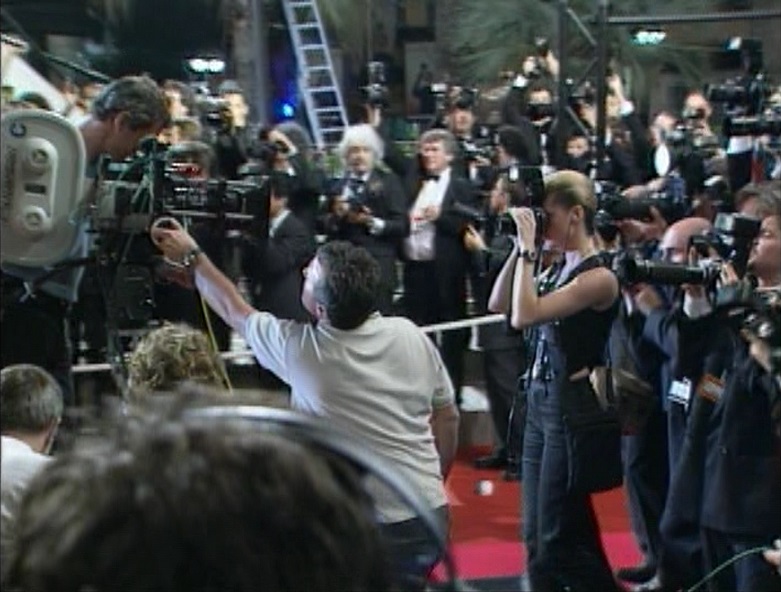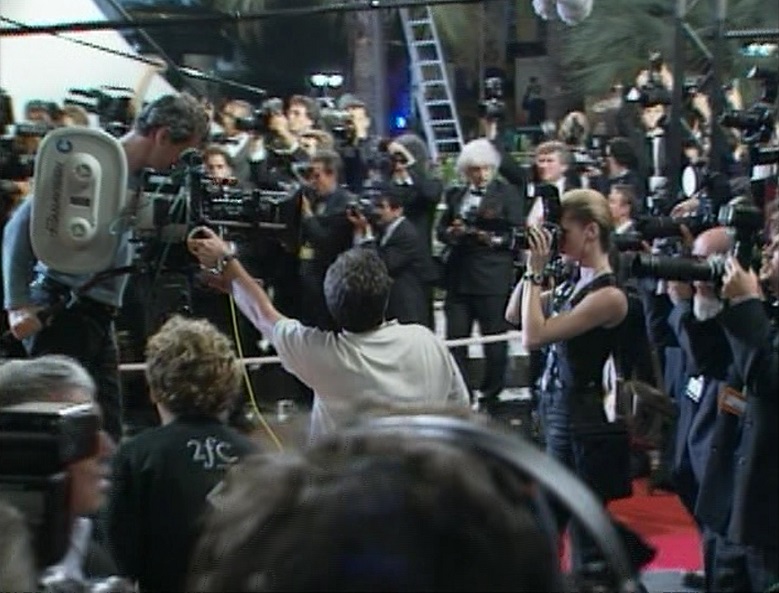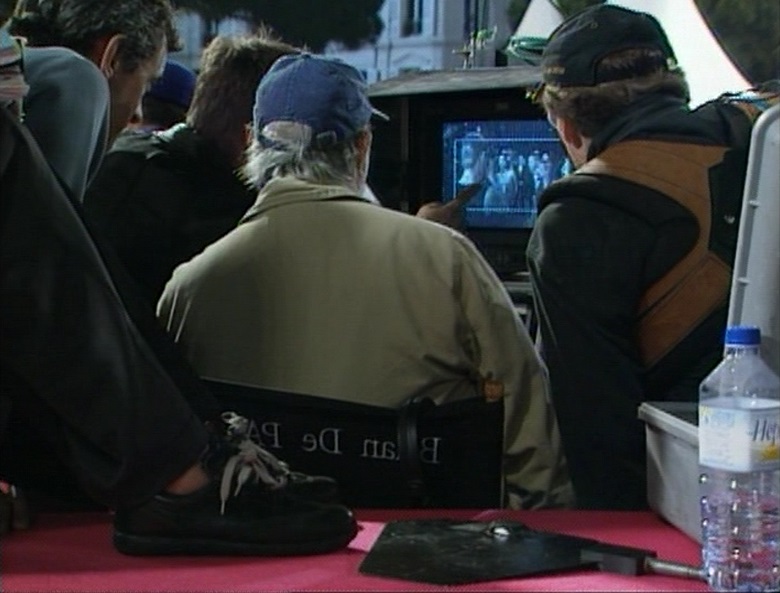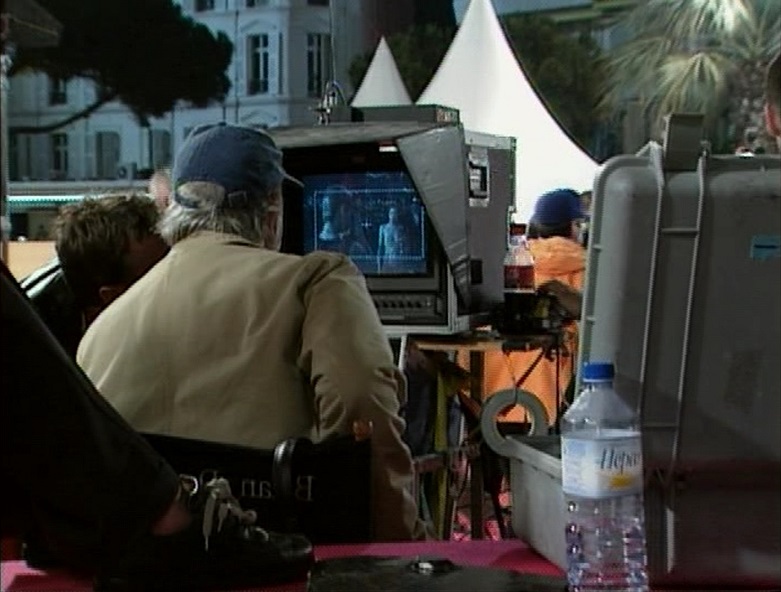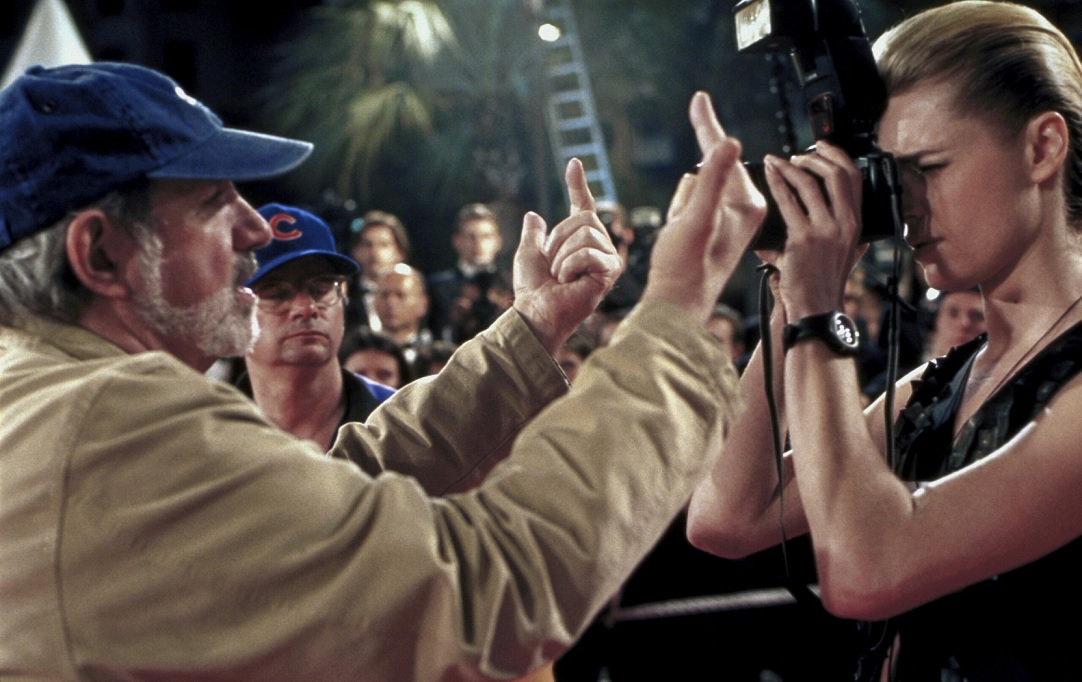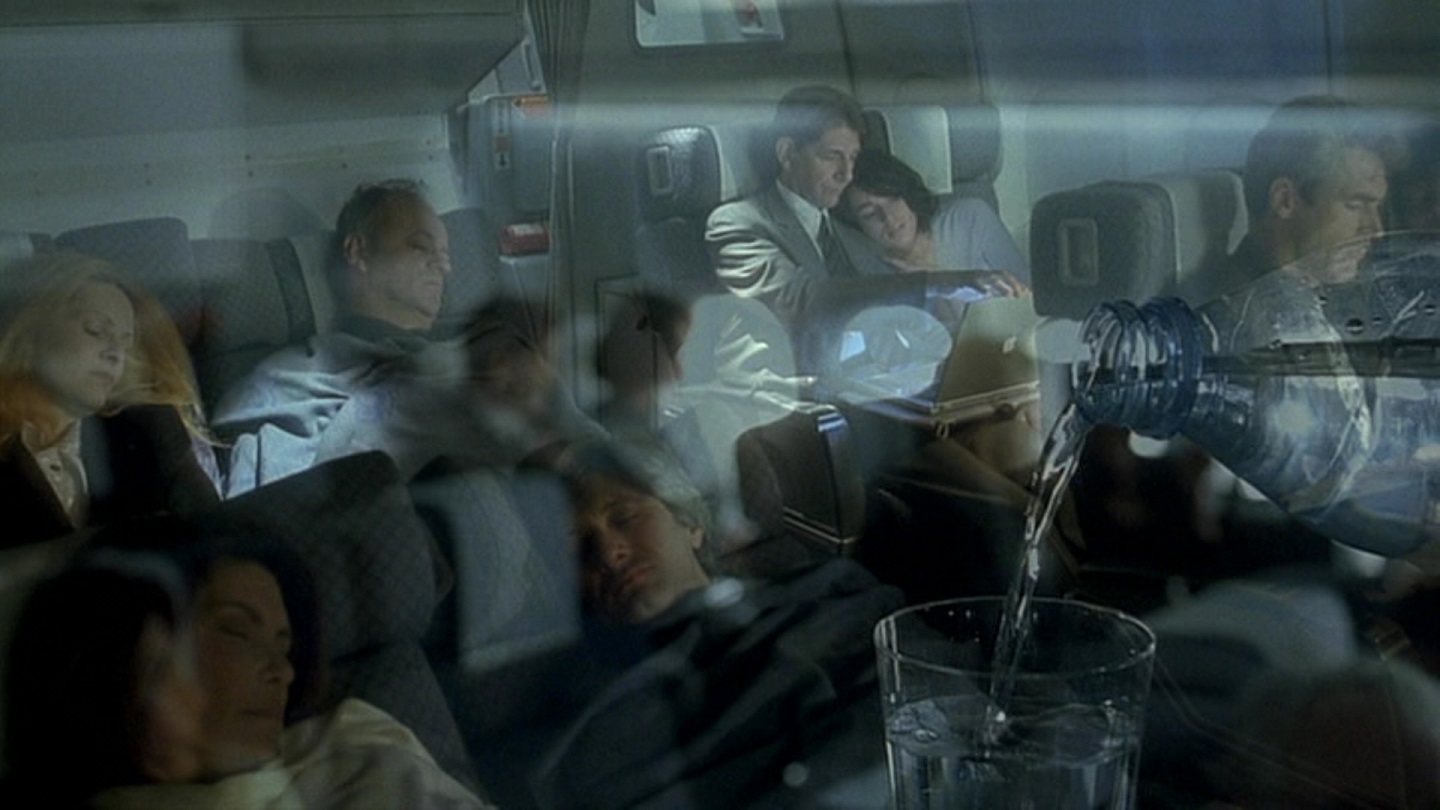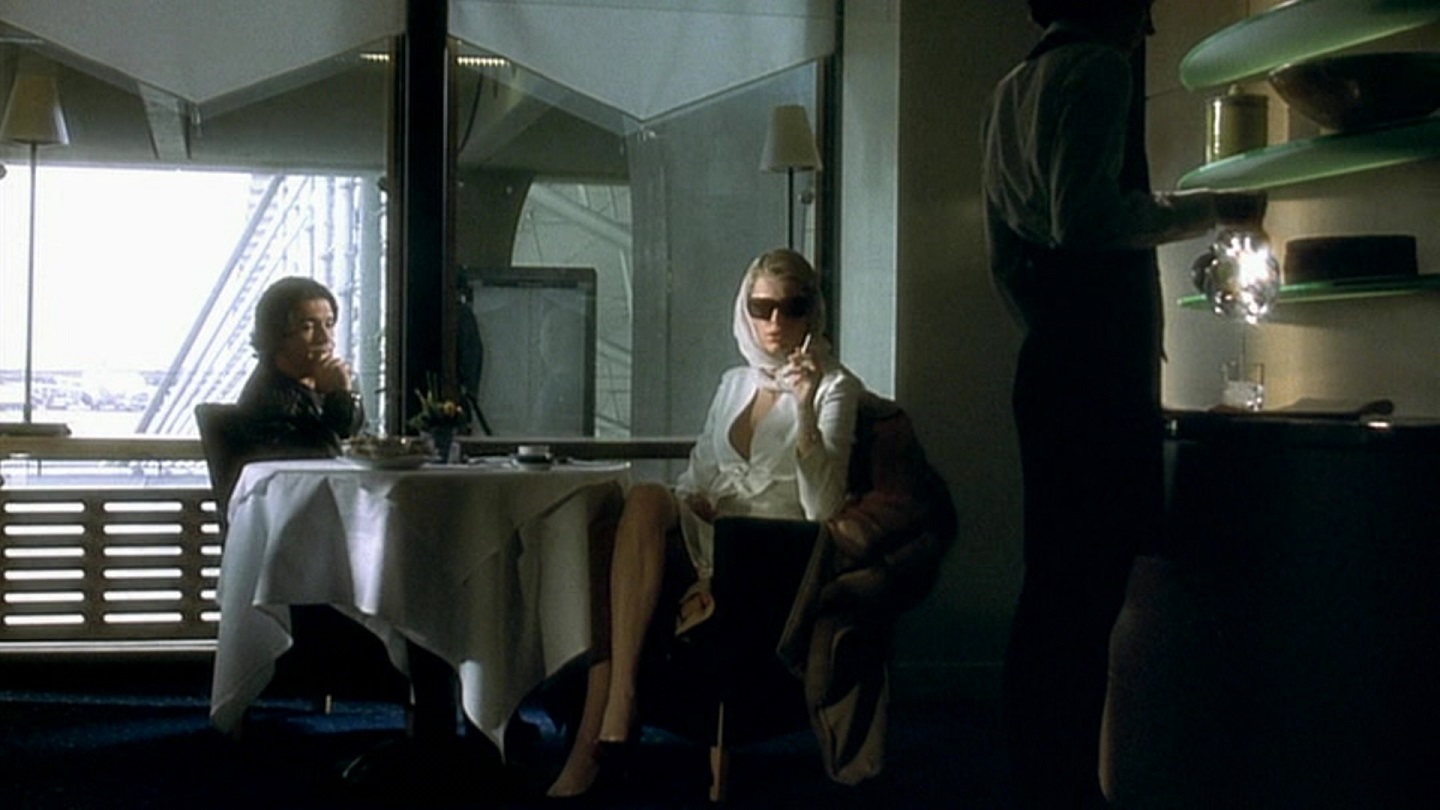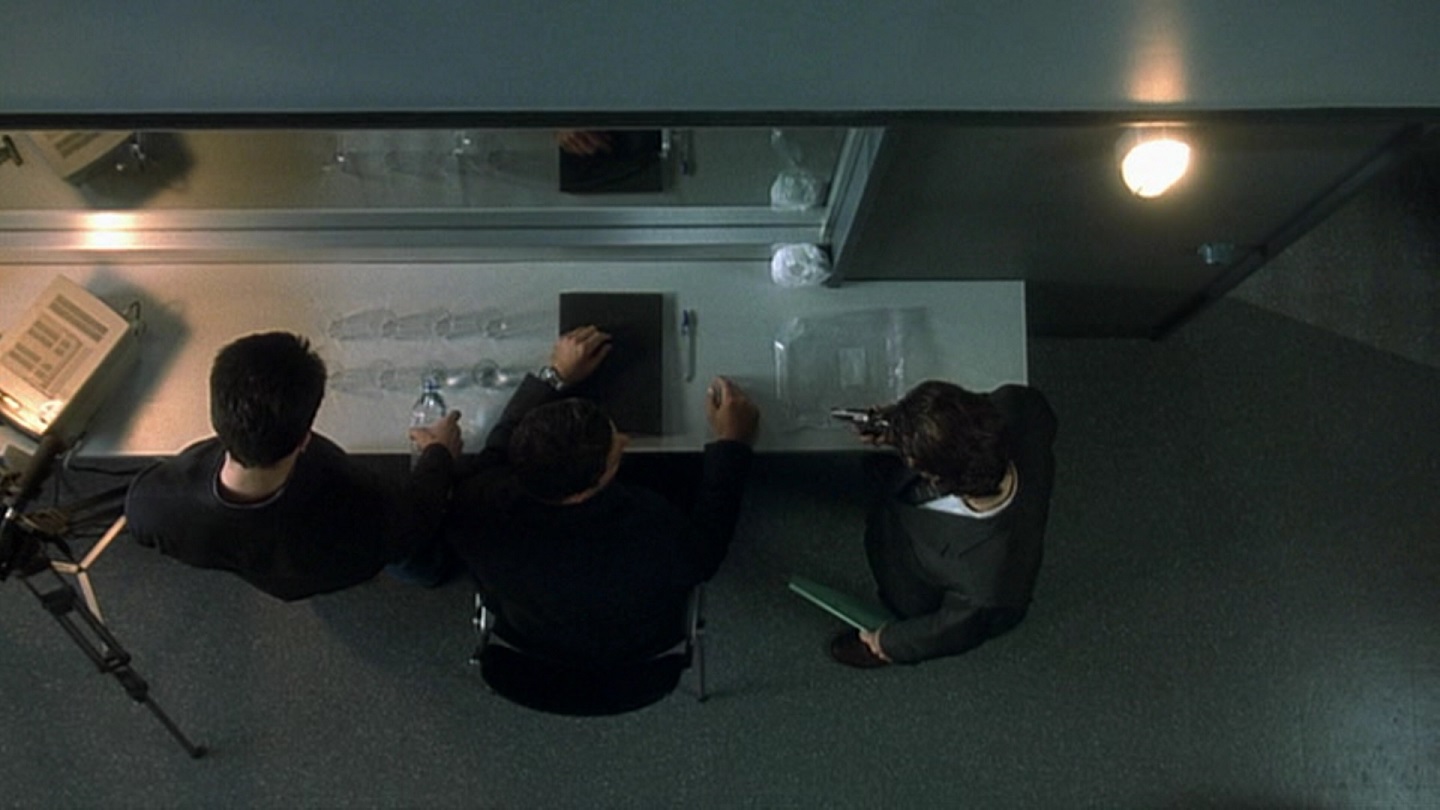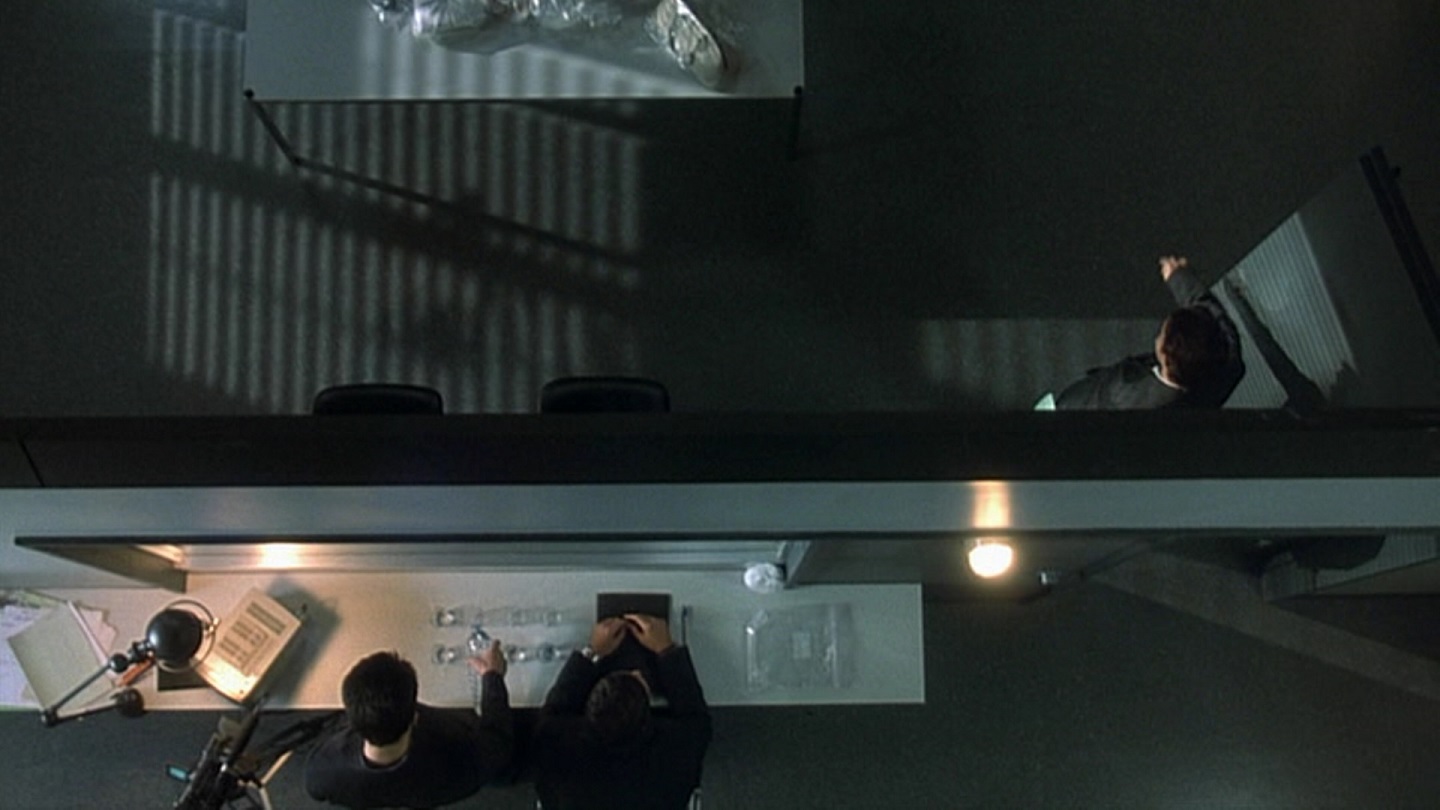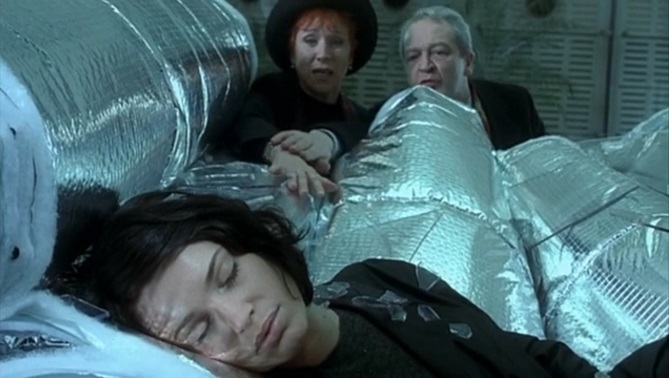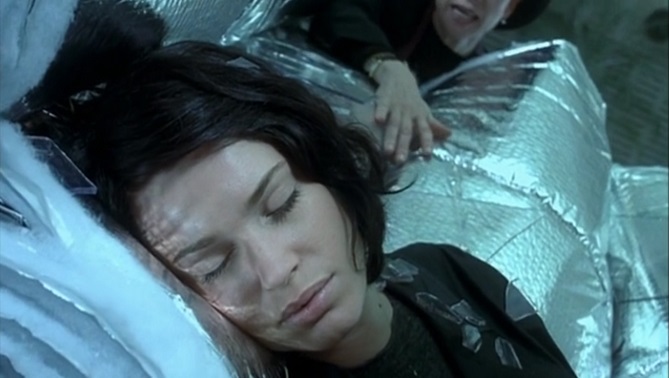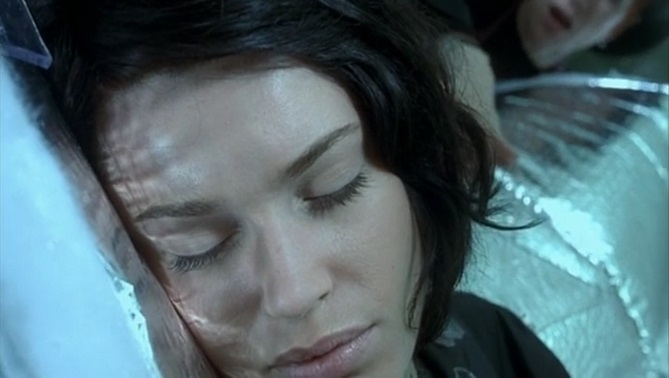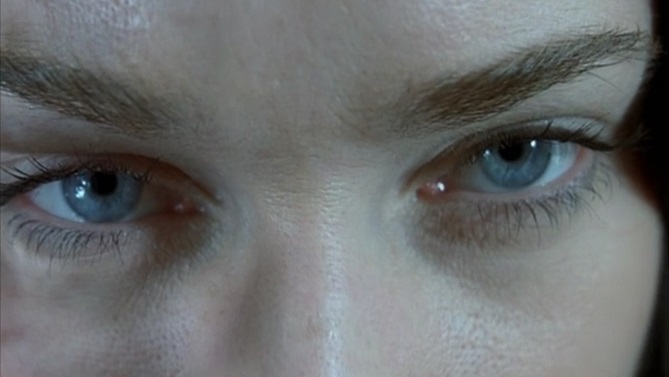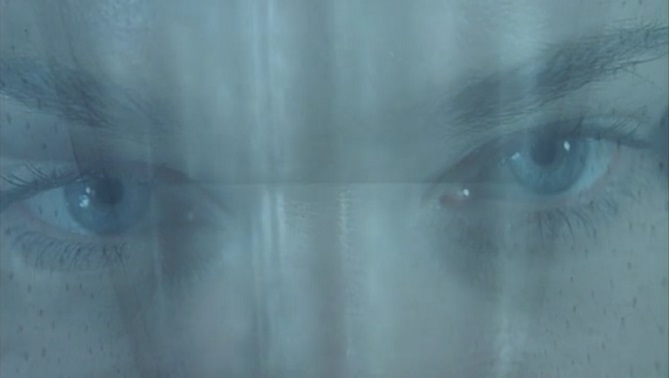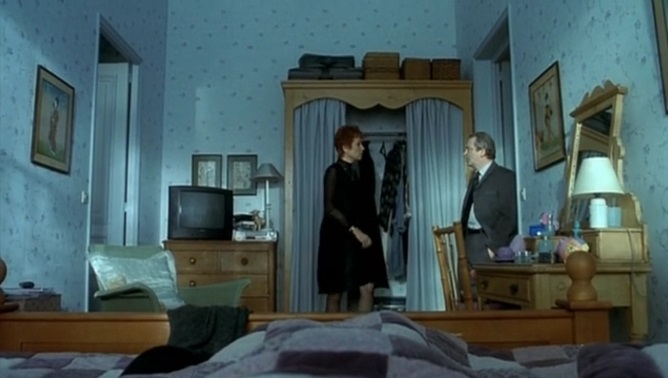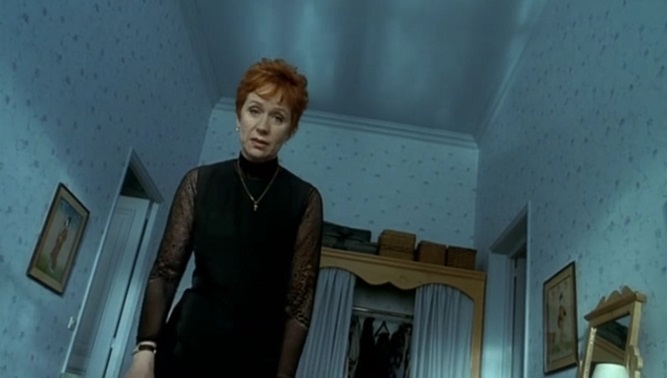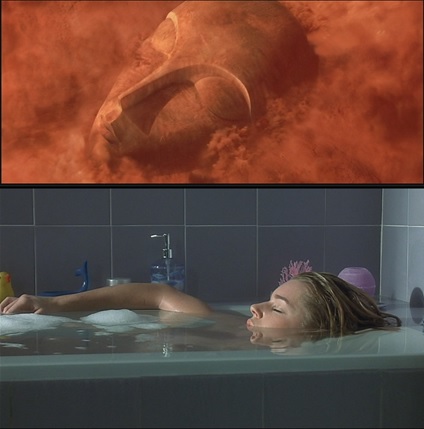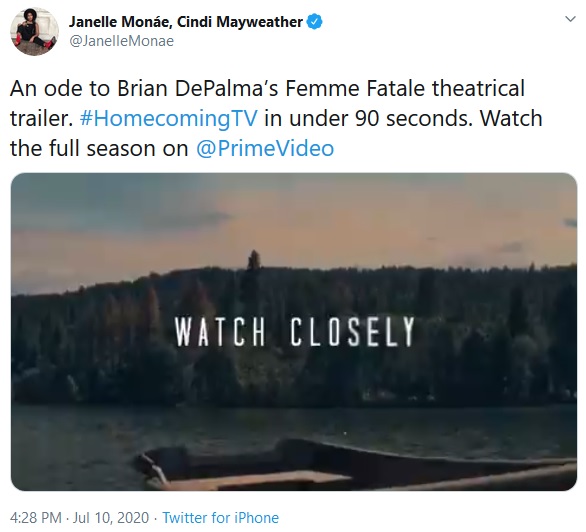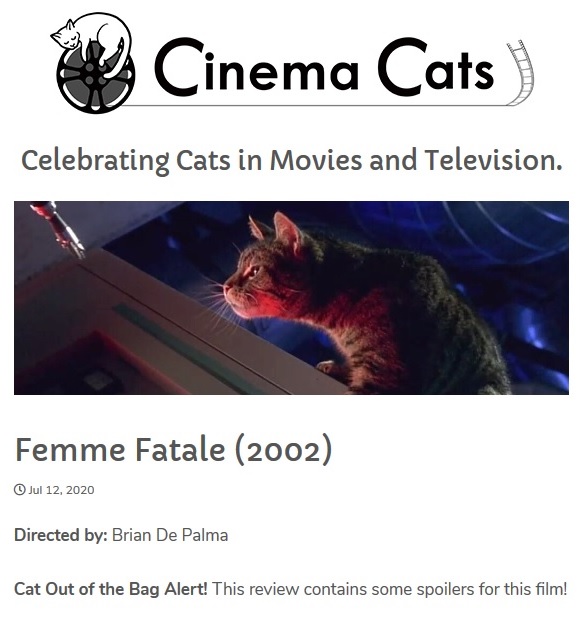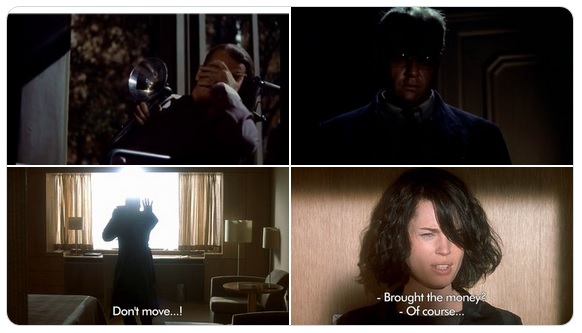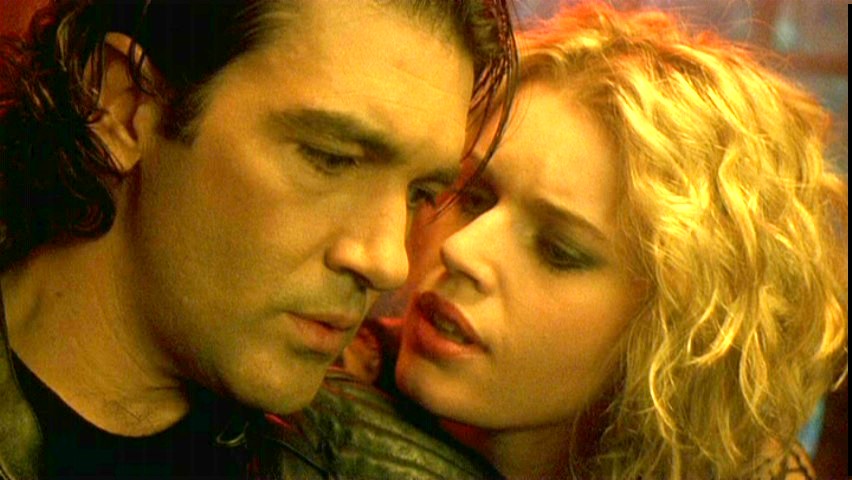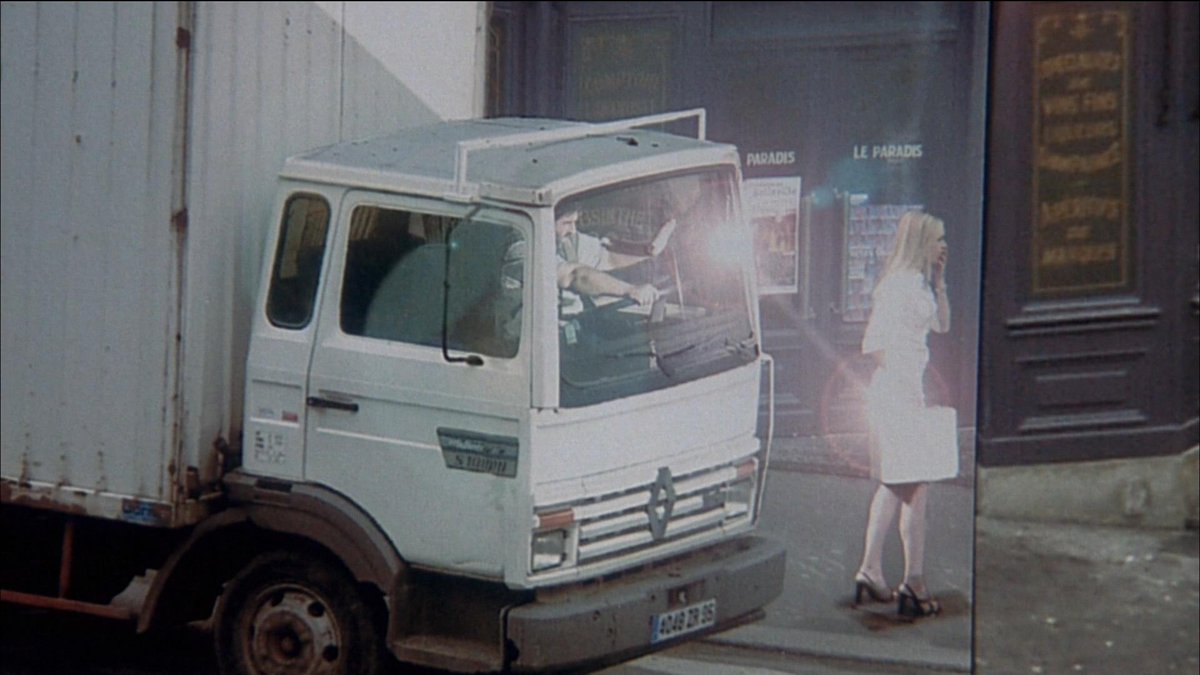. Below is a Google-assisted translation, although these tweets are best read on DAntuoni's thread, where he has included screen captures to illustrate his tweets.
Thread Analysis of "FEMME FATALE" (2002). De Palma is repeatedly said to copy Hitchcock and that he is an irregular director. Let's see particularly in this case, as what he does, is a rereading and updating of his work. In one of his least valued movies. Before starting, I clarify that the analysis will be with spoilers and that there will be several mentions of Double Indemnity (1944), Rear Window (1954), Vertigo (1958), Psycho (1960) and Body Double (1984).
"Femme Fatale" is among many things, a revision to the figure of the fatal woman. For this reason it begins with the reproduction of Double Indemnity by Billy Wilder. Fundamental film for film noir, the characteristics of the "femme fatale" and the figure of the double.
In this close-up of the film, Laure is reflected and blurred in the screen. Establishing the mix of reality with fiction and the oneiric (which was later proposed by Brian De Palma).
In the scene he watches from Double Indemnity, he goes from general to specific (there is a close-up of the shots). In Femme Fatale the opposite occurs: De Palma uses a traveling backward, going from Laure's reflection (his double) to his presentation; backwards.
But let's detail several more particularities of this entire initial scene, which lasts almost 5 minutes and has no cuts:
The backward traveling responds to the fact that: both Laure, De Palma's own film and cinema understand that one must know the above (the history of cinema). The present and the future are built from the past (which is going to happen literally in the film).
Laure shows up and almost the whole scene is turned on her back: we understand that there is something behind it and that it will be pursued and observed throughout the story.
It is the first voyeuristic act in a double way: we (spectators) see Laure (and she does not see us). At the same time she sees Phyllis from DI (who doesn't see her). This will be maintained throughout the film (chases of 3 people) where there is someone who does not know that they are watching.
She is lying down: since she is going to dream (literally) much of the film.
In addition to the Billy Wilder movie, "Femme Fatale" will dialogue with Vertigo and Alfred Hitchock's Rear Window. Films that among many topics address the theme of women, and women and their relationship with men (and vice versa).
Black Tie enters "scene" being this, the "masculine" look of this femme fatale. This man gives you orders and takes a command position. Laure apparently subordinates herself to him.
Lastly, the clock and the mirror: the double, the gaze and the time are brought into play from the beginning.
To complete this whole scene, which as I mentioned has no cuts, curtains are opened -the curtain is drawn- which gives an idea of self-awareness, representation, staging and acting (later I develop all this). And it's also a link to the beginning of Rear Window.
The entire following sequence (which lasts about 15 minutes) occurs at the Cannes festival, where Laure is going to steal diamonds and betray her companions (Black Tie and Racine): and where the following themes are going to be present (which then go to make sense).
Double: Both the film shown at the festival "East West" and "Femme Fatale" is made up of two words.
2 bodyguards // 2 women accompany the director // 2 women in the bathroom // division of the same space into 2 parts.
Reflection in mirrors // 2 languages and 2 countries (France and the United States) // Number 2 in the director's passenger seat.
The circular and the fall: (relationship with Vertigo, then I return to this).
Voyeurism, the male gaze, the female gaze.
The screens:
The water, (later in the thread I explain).
At the end of this entire sequence. It is the woman who has the key (takes power) that previously passes through 3 men: she will be the protagonist / heroine of the story.
Laure is now the protagonist: therefore we see her behind the glass (screen) and the world (paris) is the one that is reflected in her. Thus reversing the foreground, where she observed a screen and reflected on it.
To hide, she will change her look (double her). Symbolically, Laure is searching for her identity.
The first split screen appears, which as is known is a resource that De Palma uses regularly. Far from being free, in a film where the gaze is a relevant topic. Viewers will have to choose and decide where to look. But this is not the only interesting thing:
De Palma uses this narratively: and shows two glances towards the woman, (in both cases they are spying on her). Laure realizes that the photographer is watching her. But he is unaware that Black Tie is doing the same. The viewer with the split screen knows everything. [A La Mod editor's note: it is not Black Tie spying here via binoculars, but his partner, Racine]
This whole scene is going to alternate different subjective of the characters, with normal planes (somehow subjective of the spectator). And it will end with (continue)
Nicolas Bardo, pasting the photo he took of Laure (reality / fiction / representation), and on the right side, a shot identical to the one that Bardo looks at, but which is not a subjective one of him.
Laure escapes from the Church and is persecuted by her (false) parents. Along the way De Palma takes the opportunity to present other characters that will appear later. Her future husband, the chief of security, the wench and Phyllips.
Very interesting that the character of the head of security is starring Gregg Henry. Actor who in Body Double plays Sam Bouchard, who represents evil and power.
Hitchcock is the master of suspense and Brian De Palma is his best student: Racine, a partner in Black Tie, is going to wait for Laure in the hotel room. The viewer knows everything beforehand and thus the tension is generated.
The attack on the woman is similar to the end of Rear Window.
Then Racine pushes her and Laure falls for the first time. Falls are essential in Hitchcock's cinema.
When Laure falls, she is "sleeping".
The photograph increases in blue tone; which is related to water and a certain trait of reverie. Through a subjective, Laure sees her (false) parents.
For the second time a television appears (beginning of the film). We already know that Laure watches and learns from what she sees in this one. In the show you watch, they ask themselves: if you could see your future, would you change it? Which is literally going to happen next.
All the movements, planes and angulations in De Palma's cinema always have a reason. Not coincidentally here, (a death) uses a zenith shot.
As in Vertigo: there is an identity replacement: (Madeleine / Judy) - (Laure / Lili) but this time it is the woman herself who decides to do it (in the form of a dream). Without neglecting that she is persecuted, by the “masculine” gaze of different men.
Anticipating us a little, Laure will reflect, (taking power): What woman does she want to be? What did you learn from the other women? What is your identity? Lili is her double but also her counterpart: she is married and had a daughter.
Let's remember the elements that appear when Laure bathes (the water, the clock). From here it is a dream of hers.
The rain of this whole scene also responds to a change, so every time it rains, Laure will change her look (identity).
Subjective of Laure that sees Lili in a kind of screen, between the kitchen frames. As we said, Lili is one of the many women that Laure observes.
Lili writes a letter saying that she is going to travel to America to start a new life. Then she loads the drum with two shots, turns it and takes aim. The first shot doesn't work but the second does (relating it like this to the scene Laure sees from Double Indeminity)
Double and circular is in every detail: De Palma makes a great ellipsis, and without showing the shot: it goes from the circular movement of the drum to the turbine of the plane. With this we already understand that Lili shot herself and that Laure took her identity.
The story jumps 7 years later where Laure returns to France and is married to Watss (the man she met on the plane)
Nicolas Bardo's presentation is repeated with the split screen. The Banderas character is going to be acting and pretending to be someone else several times. In the role play, he is also searching for his identity.
Nicolas Bardo is a kind of Scottie (Vertigo), Jeff (Rear Window) or Jake (Body Double). As these have a weakness, he has free time and is a voyeur.
On the split screen, on one side he will stay (without moving the camera) with Nicolas Bardo. On the other side, the movement from the beginning of the film is repeated: the camera moves back and goes through the church, through the deja vu poster and finally by the two women in a bar.
From the back we are presented with a woman who we think is Laure (she is not). Then Nicolas Bardo appears, posing as a blind person to take a photo of Laure.
Rear Window / Femme Fatale / Domino.
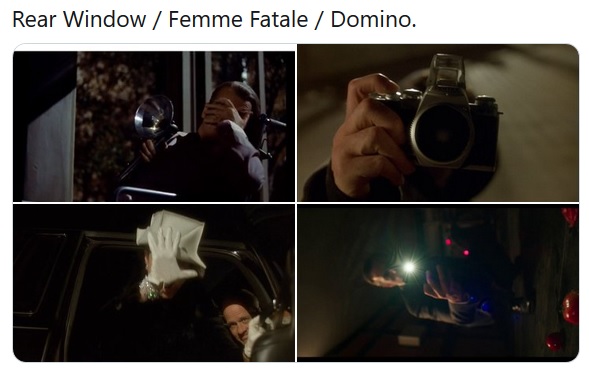
Shiff appears back, sure he wants to get Laure's photo back. Nicolas Bardo does not know that he is being watched. In this minimal conversation the double appears, the screen and the water.
Bardo enters the room performing a performance: and both are dressed in opposite colors: Laure is in white, since she simulates purity and innocence. Then when he reveals his plan, he is going to present himself in black. Also these two states coexist in it, as a double.
The cross anticipates the (symbolic) death of these two characters.
Nicolas Bardo falls in love, and Laure seduces and uses him. Like Madeleine, she appears ghostly.
In order for De Palma to tell us that Laure is cheating on Bardo, he places her in front of a mirror where she takes off her makeup (her mask).
“Femme Fatale” and film noir: a great self-conscious mystery / suicide scene and that of a detective trying to discover a case.
In Hitchcock's work: the protagonist's morality and taking charge, seeing and discovering a murder, are put into play, starting from observing the details. From a voyeuristic look, getting into the private life of another. For a photo that Bardo took, Black Tie searches for Laure
We have already discussed the role of women and the masculine gaze. Laure and Nicolas Bardo go to a bar, where they are all men and she is the center of attention.
Laure seduces Napoleon (another relationship with water) who is double of Nicolas Bardo.
Nicolas Bardo and Laure descend into "the underworld" obviously through a circular staircase.
Both men and women seek their identity, through representations. Laure stared at the Double Indeminity femme fatale. Then, I change her look and take the identity of Lili. Now before the Napoleon dance, look at another woman on the poster.
Bardo watches Laure, who unlike the close-up of the movie (from the back), is facing forward and knows that she is being watched. What it gives, a certain self-awareness within the film itself. Back the 2 masculine glances at Laure. Napoleon is here, the one with his back
Then Banderas must face and beat his double. All this shown, intelligently through shadows.
This little scene is another summary of the Femme Fatale themes. One of the protagonists (Laure) there is something she does not see, and the viewer has more information (Bardo is recording it). Both characters are acting within the fiction itself.
On the bridge, already reaching the end, all the important characters will conclude. This whole scene is reminiscent of the one Laure sees in Double Idemnity: first she cheats and kills the husband to keep her silver. Then (continue)
they both point their guns. Recall that in Double Indemnity, Phyllips shoots Neff once and does not kill him (he needs two shots), he shoots him twice and kills her.
As we already said, at any moment some of the characters are being observed without knowing it. In this case both Shiff and Black Tie watch them from a car.
Laure and Nicolas Bardo sign up, the latter has fake bullets (performance / representation).
The bridge is a symbol of union, and of power. Power, which in Veritgo invisibly has Gavin Elster, in Body Double Sam Bouchard has it. In Femme Fatale, Laure (as a woman) and Nicolas Bardo are going to try to get it. The bridge will also be the step to another life.
Symbolically, Nicolas Bardo (attention to the framing, the blood and the cross) and Laure are going to die.
Laure, like Madeleine, is going to "fall".
Water as a symbol of rebirth: If Laure dies, she will be reborn back in the bathtub.
Now, understanding that everything Laure lived through is a dream (of her future). Knowing what happens, both in your life and in the other movies, (the camera that goes backwards, relationship scene)
Laure, as a woman can decide what life to live and what identity to have. Live your own life and not that of other women.
Also, Brian De Palma, decides to give his protagonist the opportunity to redeem herself and go back. That possibility that Marion Crane did not have in Psycho.
Therefore Laure, will change the facts and her own destiny. She decides to save Lili, who gives a circular chain to a driver.
Before moving on to the end of the film, let's see how Brian de Palma, using Laure's elements in the bathtub (such as the water and the clock), leaves clues, so that the viewer, if he is attentive, knows that everything that has happened is a dream:
Water:
The clock, with the same time as the one in the bathtub.
Posters of "deja vu".
Pictures with water or referring to sleep.
The dialogues:
The Blood of Black Tie, which refers to the beginning of the film.
The double, not only seen from the plans:
The circular can be seen from objects, shapes, scenes that are repeated, or even in minute details, such as the spiral of the vase. Let me be clear, it is not just a curiosity, this is fundamental for the film and as a way of seeing life, by Brian De Palma.
Not coincidentally, with everything already explained, the characters discover or reveal situations through photos.
Now, the end: They go back 7 years and repeat the sequence already known from the split screen to Nicolas Bardo. Now it's Laure, the woman sitting at the bar.
The driver, this time is dazzled by the circular chain that Lili gave him, and instead of accidentally killing the woman, he is going to kill Black Tie and Racine. Laure changed her destiny and that of the other woman.
In the end, Laure and Nicolas Bardo instead of ending in "hell" will end in "paradise".
If "Femme Fatale" started with a fiction and "opening a curtain" it will end with Nicolas Bardo, sticking the photo of Laure on his wall, a cutout and a representation of reality, from one of his many possible lives.
Up to here the thread of "Femme Fatale" (2002) MASTERPIECE by Brian De Palma. Thanks for reading, and any doubt, contribution or suggestion is more than welcome.
